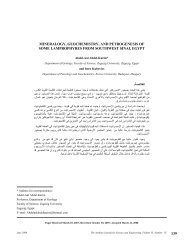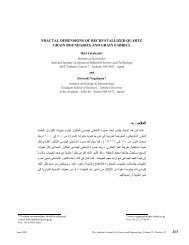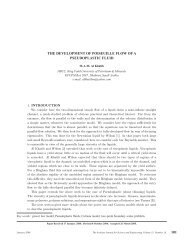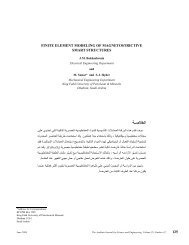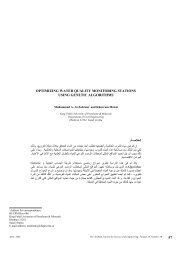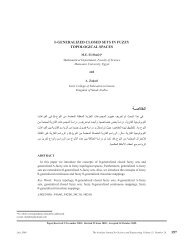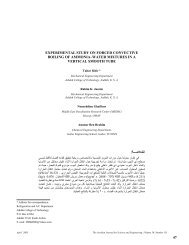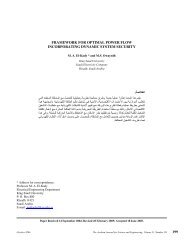lambert universal variable algorithm - Arabian Journal for Science ...
lambert universal variable algorithm - Arabian Journal for Science ...
lambert universal variable algorithm - Arabian Journal for Science ...
You also want an ePaper? Increase the reach of your titles
YUMPU automatically turns print PDFs into web optimized ePapers that Google loves.
ﺔــﺼﻼﺨﻟﺍ<br />
تﺪـﻤﺘﻋا ﺪـﻗو . ﺔـﻠﻣﺎﺸﻟا تﺮﺒﻤﻟ ﺔﻟﺄﺴﻣ ﻞـﺤﻟ ﺔـﻟﺎﻌﻓو ﺔـﻄﻴﺴﺑ ﺔـﻴﻣزراﻮﺧ ﺪﻴـﻴﺸـﺗ ﺚـﺤﺒﻟا اﺬــه ﻰﻓ ﻢـﺗ<br />
ﺔـــﻴﻃوﺮﺨﻤﻟا ﺔـــآﺮﺤﻟا عاﻮـــﻧأ ﻊــــﻴﻤﺠﻟ برﺎــــﻘـﺘﻣ يراﺮــــﻜﺗ<br />
ﻂﻄـــﺨﻣ ﻰﻠـــﻋ ﺔــــﻴﻣزراﻮﺨﻟا ﻩﺬـــه<br />
ﻒﻨﺘﺱا لاوﺪﻟ ﺔﻟﺎﻌﻓ ﺔﻘیﺮﻃ ﻰﻠﻋ ﺔﻴﻣزراﻮﺨﻟا تﻮﺘﺡا<br />
ﺪﻘﻓ ﻚﻟذ ﺐﻧﺎﺝ ﻰﻟإ ، ( ﺔیﺪﺋاز<br />
- ﺊﻓﺎﻜﻣ – ﺔﻴﺠﻴﻠهإ )<br />
ﺾﻌﺑ ﻰﻠﻋ ًﺎﻀیأ ﺚﺤﺒﻟا ﻞﻤﺘﺵاو . ﺔیدوﺎﻌﺘﻟا ﻎﻴﺼﻟاو تﻼﺴﻠﺴﺘﻤﻟا ماﺪﺨﺘﺱﺎﺑ ﻚﻟذو ، ﺔﻴﻣﺎﺴﺘﻤﻟا ( Stumpff)<br />
. ﺔﻴﻣزراﻮﺨﻠﻟ ﺔیدﺪﻌﻟا تﺎﻘﻴﺒﻄﺘﻟا<br />
ABSTRACT<br />
LAMBERT UNIVERSAL VARIABLE ALGORITHM<br />
M.A. Sharaf*<br />
Department of Astronomy, Faculty of <strong>Science</strong><br />
King Abdul-Aziz University<br />
Jeddah, Saudi Arabia<br />
and<br />
A.N. Saad † and M.I. Nouh<br />
Department of Astronomy<br />
National Research Institute of Astronomy and Geophysics<br />
Cairo, Egypt<br />
In this paper, an efficient and simple <strong>algorithm</strong> is developed <strong>for</strong> the solution of<br />
<strong>universal</strong> Lambert’s problem. The <strong>algorithm</strong> based on iterative scheme which<br />
converges <strong>for</strong> all conic motion (elliptic, parabolic, or hyperbolic). Moreover, the<br />
involved transcendental Stumpff’s functions are evaluated efficiently using series and<br />
recursion <strong>for</strong>mulae. Applications to the <strong>algorithm</strong> are also given.<br />
Key words:<br />
Universal Lambert problem, orbital boundary value problem, orbit determination.<br />
*Address <strong>for</strong> Correspondence:<br />
P.O. Box 80203<br />
Department of Astronomy, Faculty of <strong>Science</strong><br />
Jeddah 21589<br />
Saudi Arabia<br />
e-mail: Sharaf_adel@hotmail.com †e-mail: abdel_naby@yahoo.com<br />
January 2003 The <strong>Arabian</strong> <strong>Journal</strong> <strong>for</strong> <strong>Science</strong> and Engineering, Volume 28, Number 1A. 87
M.A. Sharaf, A.N. Saad, and M.I. Nouh<br />
1. INTRODUCTION<br />
LAMBERT UNIVERSAL VARIABLE ALGORITHM<br />
Lambert problem of space researches is concerned with the determination of an orbit from two position vectors and the<br />
time of flight [1]. It has very important applications in the areas of rendezvous, targeting, guidance [2], and<br />
interplanetary mission [3].<br />
Solutions to Lambert’s problem abound in the literature, as they did even in Lambert’s time shortly after his original<br />
<strong>for</strong>mulation in 1716. Examples are Lambert’s original geometric <strong>for</strong>mulation, which provides equations to determine the<br />
minimum-energy orbit, and the original Gaussian <strong>for</strong>mulation, which gives geometrical insight into the problem.<br />
Up to the year 1965, a fairly comprehensive list of references on Lambert’s problem are given in references [4–6].<br />
In 1969, Lancaster and Blanchard [7] (also Mansfield [8]) established unified <strong>for</strong>ms of Lambert’s problem; in 1990<br />
Gooding [9] developed a procedure <strong>for</strong> the solution; and in 1995, Thorne and Bain [10] developed a direct solution using<br />
the series inversion technique.<br />
Each of the above methods is characterized primarily by: (1) a particular <strong>for</strong>m of the time of flight equation; and<br />
(2) a particular independent <strong>variable</strong> to be used in an iteration <strong>algorithm</strong> to determine the orbital elements.<br />
One of the most compact and computationally efficient <strong>for</strong>ms of Lambert’s problem is that of Battin (cited in<br />
reference [11]). In this <strong>for</strong>m, the time of flight equation is <strong>universal</strong> (i.e., includes elliptic, parabolic, and hyperbolic<br />
orbits) as a well-behaved function of a single, physically significant, independent <strong>variable</strong>.<br />
In the present paper, we aim at building an <strong>algorithm</strong> <strong>for</strong> <strong>universal</strong> Lambert’s problem on the basic approach of Battin,<br />
extending it to include the following important points: (1) An iterative scheme which converges <strong>for</strong> all orbit types; and<br />
(2) an efficient procedure to evaluate the Stumpff’s functions. Applications of the <strong>algorithm</strong> are also given.<br />
2. BASIC FORMULATIONS<br />
2.1. Two-Body Formulations<br />
• The equation describing the relative motion of the two bodies of masses m1 and m2 in rectangular coordinates is:<br />
d µ<br />
v= r =− r 3 , (2.1)<br />
dt r<br />
where µ is the gravitational parameter (<strong>universal</strong> gravitational constant times the sum of the two masses), r and v<br />
are the position and velocity vectors given in components as:<br />
r = x i + y i + z i , (2.2)<br />
x y z<br />
v= x i + y i + z i , (2.3)<br />
x y z<br />
ix, iy, and iz are the unit vectors along the coordinate axes x, y, and z respectively, and<br />
2 2 2 1 2<br />
r = ( x + y + z ) . (2.4)<br />
Equation (2.1) is unchanged if we replace r with –r. Thus Equation (2.1) gives the motion of the body of mass m2<br />
relative to the body of the mass m1, or the mass m1 relative to m2. Also, if we replace t with –t, Equation (2.1)<br />
remains unchanged.<br />
88 The <strong>Arabian</strong> <strong>Journal</strong> <strong>for</strong> <strong>Science</strong> and Engineering, Volume 28, Number 1A. January 2003
• On any of the two bodies’ orbits (elliptic, parabolic, or hyperbolic) we have:<br />
M.A. Sharaf, A.N. Saad, and M.I. Nouh<br />
r = Fr + G v , (2.5)<br />
0 0<br />
v = F r + G v , (2.6)<br />
0 0<br />
where (r0, v0) are the position and velocity vectors at time to, while (r, v) are the corresponding vectors at another<br />
time t. The coefficients F and G are functions of ∆t = t–to and known as the Lagrange F and G functions; F and<br />
G are their time derivatives such that<br />
FG − GF<br />
= 1.<br />
(2.7)<br />
Equation (2.7) implies that, given any three of the four functions F, G, F , or G , we can solve <strong>for</strong> the remaining<br />
one.<br />
There are different <strong>for</strong>ms of F, …, G [12], but what important to us are their expressions in terms of the change<br />
∆ f = f − f in the true anomaly, which are<br />
0<br />
r<br />
F = 1 − [1−cos( ∆ f )] , (2.8)<br />
p<br />
1<br />
G = r r0sin( ∆f)<br />
, (2.9)<br />
µ p<br />
( )<br />
( ∆ )<br />
( )<br />
⎡1 cos ⎤<br />
µ − ∆f ⎡1−cos ∆f<br />
1 1 ⎤<br />
F = ⎢ ⎥ ⎢ − − ⎥,<br />
(2.10)<br />
p ⎢⎣ sin f ⎥⎦ ⎣ p r r0⎦<br />
r<br />
G = − − ∆f<br />
p<br />
0 1 [1 cos( )]<br />
, (2.11)<br />
where p is the semi-latus rectum of the orbit, r and r0 are the magnitudes of the position vectors r and r0<br />
respectively.<br />
• The total energy constant <strong>for</strong> the two-body problem is –µ/2a, where a is the semi-major axis of the orbit. It is<br />
convenient to write α <strong>for</strong> 1/a, so that, at the time t0 (say), the constant α is<br />
2<br />
1 2 υ0<br />
α=α0 ≡ = −<br />
a r0<br />
µ<br />
, (2.12)<br />
where ν0 is the magnitude of the velocity vector v0. Depending on the sign of α, or the value of the eccentricity e,<br />
the type of the orbit is determined such that: α > 0 (or e < 1) <strong>for</strong> elliptic orbits; α = 0 (or e = 1) <strong>for</strong> parabolic orbits<br />
and α < 0 (or e > 1) <strong>for</strong> hyperbolic orbits.<br />
2.2. Universal Fomulations of the Two-Body Problem<br />
• Different <strong>for</strong>mulations <strong>for</strong> the various two-body orbits can be unified by using (1) a time trans<strong>for</strong>mation <strong>for</strong>mula;<br />
and (2) a new family of transcendental functions.<br />
Regarding the first point, we shall use Sundman’s time trans<strong>for</strong>mation [12] defined by:<br />
dt<br />
µ = r , (2.13)<br />
dχ<br />
January 2003 The <strong>Arabian</strong> <strong>Journal</strong> <strong>for</strong> <strong>Science</strong> and Engineering, Volume 28, Number 1A. 89
M.A. Sharaf, A.N. Saad, and M.I. Nouh<br />
where χ is to be considered as a new independent <strong>variable</strong> — a kind of generalized anomaly. It could be shown<br />
[12] that when χ is used as the independent <strong>variable</strong> instead of the time t, then the non-linear equations of motion<br />
can be converted into linear, constant coefficients, differential equations.<br />
For t0 and t, the <strong>variable</strong> χ can be related to the classical anomalies by:<br />
( )<br />
⎧ a E−E0<strong>for</strong> α > 0<br />
⎪<br />
⎪ ⎛ 1 1 ⎞<br />
χ= ⎨ a⎜tan f −tan f0<strong>for</strong><br />
α= 0<br />
2 2<br />
⎟<br />
, (2.14)<br />
⎪ ⎝ ⎠<br />
⎪<br />
⎪⎩<br />
−a( H −H0) <strong>for</strong> α < 0<br />
where E and H are respectively, the elliptic eccentric anomaly and the hyperbolic eccentric anomaly.<br />
Regarding the second point mentioned above, we shall consider <strong>for</strong> the family of transcendental functions, the<br />
generating functions:<br />
C<br />
n<br />
∞<br />
( z) = ∑ ( −1)<br />
k = 0<br />
k<br />
k<br />
z<br />
, n = 0,1,2,… (2.15)<br />
2 !<br />
( k + n )<br />
and are known as Stumpff functions [1]; they are well defined <strong>for</strong> a complex <strong>variable</strong> z, since the power series is<br />
convergent at any point in the complex plane. They are real values <strong>for</strong> real z. Note also that:<br />
1<br />
Cn(0)<br />
= . (2.16)<br />
n !<br />
What concerns us in the subsequent analysis are the following relations between C2 and C3 of arguments ψ and<br />
4ψ:<br />
C (4 ψ ) = [ C ( ψ ) + C ( ψ) −ψC ( ψ) C ( ψ)]/4<br />
, (2.17)<br />
3 2 3 3 2<br />
1<br />
2 2 3<br />
2<br />
C (4 ψ ) = {1 −ψC ( ψ)}<br />
. (2.18)<br />
• The <strong>universal</strong> <strong>for</strong>m of the F, …, G functions which are valid <strong>for</strong> any type of conic motions are given as [11]:<br />
2<br />
χ<br />
2<br />
F = 1 − C2(<br />
α0χ) , (2.19)<br />
r<br />
0<br />
3<br />
χ<br />
2<br />
G = t−t0 − C 3( α0χ) , (2.20)<br />
µ<br />
0<br />
2 2<br />
{ 0 3( 0 ) 1}<br />
F<br />
µ<br />
= χ α χ C α χ −<br />
rr<br />
2.3. Universal Lambert Problem<br />
2<br />
, (2.21)<br />
G<br />
χ<br />
2<br />
= 1 − C2(<br />
α0χ) . (2.22)<br />
r<br />
The <strong>for</strong>mulations of the <strong>universal</strong> Lambert problem could easy be obtained [11] using the two sets of Equations (2.8)<br />
to (2.11) and Equations (2.19) to (2.22), and summarized in stepwise <strong>for</strong>m as follows:<br />
90 The <strong>Arabian</strong> <strong>Journal</strong> <strong>for</strong> <strong>Science</strong> and Engineering, Volume 28, Number 1A. January 2003
• Equating Equations (2.8) and (2.19) and then solve <strong>for</strong> the <strong>universal</strong> <strong>variable</strong> χ we get<br />
0 χ = − ∆<br />
pC2<br />
M.A. Sharaf, A.N. Saad, and M.I. Nouh<br />
rr<br />
(1 cos f ) , (2.23)<br />
where C2 = C2(α0χ 2 ). Also let C3 = C3(α0χ 2 ) below.<br />
• Substituting Equation (2.23) into Equation (2.21) and then equate it with F of Equation (2.10) we get<br />
where<br />
Also,<br />
A( ψC3−1) B = r0+ r+<br />
, (2.24)<br />
C<br />
A= sin ∆f<br />
2<br />
r r0<br />
1−cos∆f , (2.25)<br />
r r0<br />
B = (1 −cos ∆f)<br />
, (2.26)<br />
p<br />
0<br />
2<br />
ψ =α χ . (2.27)<br />
χ=<br />
B<br />
, (2.28)<br />
C<br />
2<br />
1<br />
cos ∆ f = ( r.r 0 ) , (2.29)<br />
rr<br />
0<br />
1<br />
sin ∆ f = r0× r . (2.30)<br />
rr<br />
0<br />
• Solve <strong>for</strong> ∆t = t–t0 from Equations (2.20) and (2.9) we get<br />
3<br />
µ∆ t = χ C + A B . (2.31)<br />
3<br />
• Finally, the unknown velocity vectors v0 and v are obtained from<br />
1<br />
v0 = r−r0F G<br />
( )<br />
, (2.32)<br />
1<br />
v = ( G r−r0) , (2.33)<br />
G<br />
where from Equations (2.25)<br />
= 1−<br />
B<br />
F , (2.34)<br />
r<br />
0<br />
B<br />
G = A , (2.35)<br />
µ<br />
G<br />
= 1−<br />
B<br />
. (2.36)<br />
r<br />
January 2003 The <strong>Arabian</strong> <strong>Journal</strong> <strong>for</strong> <strong>Science</strong> and Engineering, Volume 28, Number 1A. 91
M.A. Sharaf, A.N. Saad, and M.I. Nouh<br />
3. COMPUTATIONAL DEVELOPMENTS<br />
3.1. Computations of Stumpff’s Functions C2(ψ) and C3(ψ)<br />
An efficient <strong>algorithm</strong> was developed recently [13] <strong>for</strong> computing Cj(ψ); j = 0, 1, 2, 3. In what follows, this <strong>algorithm</strong><br />
will be modified to compute C2(ψ) and C3(ψ) only.<br />
It is most efficient to compute C2 and C3 by series (Equation (2.15)). On the other hand, it is inefficient to use the<br />
series except <strong>for</strong> small values of the argument; but if the input argument is too large, it can be reduced by using<br />
Equations (2.17) and (2.18) as illustrated in what follows.<br />
Now, suppose that the series <strong>for</strong> C2 and C3 are only to be used <strong>for</strong> values of ⎪ψ⎪ ≤ ψm < 1. The series might be found<br />
using a loop that would include a test to terminate it when the necessary accuracy was achieved according to a given<br />
tolerance ε (say). Thus, if we write C2(ψ) or C3(ψ) as<br />
C( ) H , (3.1)<br />
ψ =∑ N<br />
k=<br />
0<br />
k<br />
then, it is easy to show from Equation (2.15) that, the H’s coefficients satisfy the recurrence <strong>for</strong>mula<br />
ψ<br />
Hk+ 1 =−<br />
Hk<br />
, (3.2)<br />
2( k + 2)(2 k+η)<br />
where (η, H0) is (3, 1/2) <strong>for</strong> computing C2(ψ) and (5, 1/6) <strong>for</strong> computing C3(ψ), while the positive integer N is<br />
determined by the condition that<br />
H ≤ε.<br />
(3.3)<br />
N<br />
The computations of C2(ψ) or C3(ψ) <strong>for</strong> ⎪ψ⎪ ≤ ψm < 1 are illustrated by the following <strong>algorithm</strong>.<br />
3.1.1. Computational Algorithm 1<br />
• Purpose: To compute C2(ψ) or C3(ψ) using Equations (3.1) and (3.2), together with the corresponding value of N.<br />
• Input: ψ, H0, η, ε, M (large positive integer).<br />
• Computational Sequence:<br />
1. Set<br />
H = H0<br />
C = H0<br />
K = 2<br />
L = η<br />
2. For i = 1, 2, …, M, do:<br />
ψ<br />
Set H =− * H<br />
2* K * L<br />
If ⎪H⎪≤ ε go to step 3<br />
C = C + H<br />
K = K + 1<br />
L = L + 2<br />
3. N = i<br />
4. End<br />
92 The <strong>Arabian</strong> <strong>Journal</strong> <strong>for</strong> <strong>Science</strong> and Engineering, Volume 28, Number 1A. January 2003
M.A. Sharaf, A.N. Saad, and M.I. Nouh<br />
Having obtained C2 and C3 <strong>for</strong> a value of ψ such that ⎪ψ⎪≤ ψm < 1, it remains to compute their values <strong>for</strong> any<br />
given ψ. The following <strong>algorithm</strong> illustrates these computations.<br />
3.1.2. Computational Algorithm 2<br />
• Purpose: To compute C2(ψ) and C3(ψ) <strong>for</strong> any ψ using series and recursion.<br />
• Input: ψ, ψm.<br />
• Computational Sequence:<br />
1. Set K = 0<br />
2. If ⎪ψ⎪≤ ψm go to step 5<br />
3. Set K = K + 1, ψ = ψ/4<br />
4. Go to step 2<br />
5. Compute C2 and C3 using <strong>algorithm</strong> 1<br />
6. If K = 0 go to step 11<br />
7. Set K = K – 1<br />
8. Compute C3 and C2 from Equations (2.17) and (2.18) respectively<br />
9. Set ψ = 4*ψ<br />
10. Go to step 6<br />
11. End<br />
3.2. Implementing the Universal Lambert Problem<br />
Bate, Mueller, and White [14] present a Newton iterative scheme to find ψ. Newtonian iteration works fine on most<br />
problems but fails to converge on many difficult (hyperbolic) orbits. To overcome this difficulty, Vallado and McClain<br />
[15] suggested a bisection technique which works well on all orbit types but is only about 5% slower. In this case, the<br />
object is to find the value of ψ that corresponds to the given change in time (∆t). This could be done by bounding the<br />
correct value of ψ and picking a trial value of ψ halfway between these bounds. Subsequent iterations determine the<br />
upper and lower bounds and successively readjust them until the interval <strong>for</strong> ψ is tight enough to locate the correct value<br />
of ψ.<br />
Finally, it should be noted that, traveling between two specified points can take the long way or the short way. For the<br />
long way, the change ∆f in the true anomaly exceeds 180°, while <strong>for</strong> the short way ∆f < 180°.<br />
The solution of a Lambert problem using the bisection technique is illustrated in the following <strong>algorithm</strong>.<br />
3.2.1. Computational Algorithm 3<br />
• Purpose: To solve the <strong>universal</strong> Lambert problem <strong>for</strong> the velocity vectors v0 and v.<br />
• Input: r0 ≡ (x0, y0, z0);<br />
r ≡ (x, y, z); ∆t;<br />
ψ0 (initial value); ψu (upper value); ψL ( lower value);<br />
tm (tm = + 1 <strong>for</strong> short way transfers, tm = –1 <strong>for</strong> long way transfers);<br />
M (large positive integer), Tol (specified tolerance) and µ.<br />
January 2003 The <strong>Arabian</strong> <strong>Journal</strong> <strong>for</strong> <strong>Science</strong> and Engineering, Volume 28, Number 1A. 93
M.A. Sharaf, A.N. Saad, and M.I. Nouh<br />
• Computational Sequence:<br />
2 2 2 1 2<br />
0 0 0<br />
1. r0 = ( x + y + z ) .<br />
2. r = (x 2 + y 2 + z 2 ) 1/2 .<br />
3. γ = (x*x0 + y*y0 + z*z0)/(r*r0).<br />
4. β = tm (1 – γ 2 ) 1/2 .<br />
5. A = tm [r*r0*(1 + γ)] 1/2 .<br />
6. If A = 0, we cannot calculate the orbit, then go to step 11.<br />
7. For i: = 1 to M do<br />
begin{i}<br />
ψ = ψ0<br />
Compute C2(≡ C2(ψ)) and C3(≡ C3(ψ)) using <strong>algorithm</strong> 2.<br />
1<br />
B = r + r+ A∗ ∗C −<br />
{ ( ψ 1)<br />
}<br />
0 2<br />
C2<br />
If A > 0.0 and B < 0.0, then readjust ψL until B > 0.0<br />
χ=<br />
B<br />
C<br />
2<br />
3 ( 3 )<br />
1<br />
∆ t = χ ∗ C + A∗ B<br />
µ<br />
If ∆t−∆ t< Tol, go to step 8<br />
∆t ≤∆t set ψ =ψ , go to step 7.1<br />
If L<br />
Set ψu = ψ<br />
7.1.<br />
ψ = ( ψ +ψ )<br />
1<br />
1 2 u L<br />
ψ0 = ψ1<br />
End {i}<br />
8. Compute F, G, and G from Equations (2.34), (2.35), and (2.36) respectively.<br />
1 1 1<br />
x ( x x F); y ( y y F); z( z z F)<br />
G G G<br />
9. 0 = − 0 0 = − 0 0 = − 0<br />
1 1 1<br />
( ); ( ); ( )<br />
G G G<br />
10. x = Gx− x0 y = Gy− y0 z = Gz−z0 11. End<br />
94 The <strong>Arabian</strong> <strong>Journal</strong> <strong>for</strong> <strong>Science</strong> and Engineering, Volume 28, Number 1A. January 2003
3.2.2. Comments:<br />
• The initial limits of ψ are chosen to let the most common solutions converge.<br />
• For very eccentric (hyperbolic) orbits, one should expand the lower negative limit.<br />
M.A. Sharaf, A.N. Saad, and M.I. Nouh<br />
• To reduce the size of numbers involved in calculations, to make operations more mathematically stable, and also<br />
to speed up the <strong>algorithm</strong>, we used canonical units, such that, <strong>for</strong> the heliocentric system, length, mass, and time<br />
are expressed in astronomical units, solar masses, and days, respectively and the Gaussian gravitational constant<br />
given exactly [16] by<br />
k = k ⊗ = 0.01720209895 .<br />
While <strong>for</strong> the geocentric system, length, mass, and time are expressed in Earth’s radii, Earth’s masses, and<br />
minutes, respectively. By analogy with the heliocentric system, we shall assume a fundamental geocentric<br />
gravitational constant given by<br />
k = k ⊕ = 0.074366864 .<br />
In both systems the gravitational parameter µ = 1.<br />
3.3. Numerical Applications<br />
We used three Earth test bodies with position vectors r0 ≡ ( x0, y0, z 0)<br />
and r ≡ (x, y, z) listed in Table 1 together with<br />
the eccentricities e and their types. The position vectors are expressed in the geocentric canonical unit ER<br />
(ER = 6378.1363 km). Computational <strong>algorithm</strong> 3 is then applied <strong>for</strong> each orbit with µ = 1, Tol = 10 –7 , M = 50, tm = 1<br />
(short way transfer), and ∆t = 5 TU (unit of time TU = 1/k⊕ = 13.446849 solar min). The initial limits of ψ are chosen <strong>for</strong><br />
each orbit so as to secure the convergence of the solution. The values of these limits are listed <strong>for</strong> each orbit in the<br />
second, third, and fourth columns of Table 2, while the other columns of the table are devoted to the final values of B, χ,<br />
and ψ1.<br />
The resulting velocity vectors v ≡ vx vy vz and v ≡ ( vx, vy, vz) are listed in Table 3 and expressed in canonical<br />
0 ( , , )<br />
0 0 0<br />
units ER/TU(ER/TU = 7.905367km/sec).<br />
Table 1. Position Vectors <strong>for</strong> the Test Orbits.<br />
Orbit 1 Orbit 2 Orbit 3<br />
xo 1.01566 ER –0.253513 ER –0.668461 ER<br />
yo 0.0 ER 1.21614 ER –2.05807 ER<br />
z o 0.0 ER –1.20916 ER –1.9642 ER<br />
x 0.387926 ER –0.434366 ER 3.18254 ER<br />
y 0.183961 ER 4.92818 ER 2.08111 ER<br />
z 0.551884 ER 0.0675545 ER –4.89447 ER<br />
e 0.9114797 1.0 4.2100249<br />
Type Elliptic Parabolic Hyperbolic<br />
Table 2. The Initial Limits of ψ and the Final values of B, χ, and ψ 1.<br />
Orbit ψ o ψ u ψ L Β χ ψ 1<br />
1 0.8 4π 2<br />
2 0.8 4π 2<br />
3 –0.1 4π 2<br />
–4π 2<br />
–4π 2<br />
1.91549 3.3704 11.6446<br />
1.27779 1.59862 0.0<br />
–2 0.990575 1.30274 –1.88569<br />
January 2003 The <strong>Arabian</strong> <strong>Journal</strong> <strong>for</strong> <strong>Science</strong> and Engineering, Volume 28, Number 1A. 95
M.A. Sharaf, A.N. Saad, and M.I. Nouh<br />
Table 3. Solution of the Universal Lambert Problem <strong>for</strong> the Velocity Vectors v 0 and v.<br />
Orbit 1 Orbit 2 Orbit 3<br />
vx 0 0.885477 ER/TU –0.0851362 ER/TU 0.788746 ER/TU<br />
vy 0 0.126493 ER/TU 1.06699 ER/TU 0.748957 ER/TU<br />
vz 0 0.379481 ER/TU 0.0892477 ER/TU –0.782571 ER/TU<br />
v x –1.16237 ER/TU –0.0159003 ER/TU 0.727364 ER/TU<br />
v y –0.220033 ER/TU 0.564771 ER/TU 0.828386 ER/TU<br />
v z –0.660101 ER/TU 0.291558 ER/TU –0.467453 ER/TU<br />
In concluding the present paper, an efficient and simple <strong>algorithm</strong> <strong>for</strong> the solution of the <strong>universal</strong> Lambert’s problem<br />
of the space dynamics has been developed. Its efficiency is due to several factors; of these some are the following:<br />
(1) Based on iterative scheme that could be made to cover all conic motion. The scheme uses a bisection technique;<br />
although it is somewhat slow, it usually bounds one root on the interval. On the other hand, Newton iteration<br />
[14] works fine on most problems but fails to converge on many difficult (hyperbolic) orbits. There is full<br />
agreement that the Newton method is extremely sensitive to the initial guess [17]. Moreover, in many cases the<br />
initial guess may lead to drastic situations between divergent and very slowly convergent solutions. Such<br />
discouraging facts aside, recent progress in numerical solution of nonlinear equations has given us techniques<br />
whose convergence properties are more global than <strong>for</strong> the Newton method. These techniques are known as<br />
homotopy continuation methods [18], and have been applied recently in space dynamics [15, 19].<br />
(2) Our <strong>algorithm</strong> includes a very fast procedure to evaluate the Stumpff’s functions, which are the basic functions<br />
<strong>for</strong> all <strong>for</strong>ms of the <strong>universal</strong> Lambert’s problem.<br />
(3) The accuracy of the <strong>algorithm</strong> was confirmed by using ( r,v 0 0)<br />
of each orbit as initial values at t = 0 <strong>for</strong> the<br />
Runge–Kutta fourth order method (with fixed step size) to integrate the two-body equations of motion<br />
(Equation (2.1)). The resulting components of v at the given value of t(t = 5) are in full agreement with those<br />
obtained from our <strong>algorithm</strong> 3.<br />
REFERENCES<br />
[1] J.M.A. Danby, Fundamental of Celestial Mechanics, 2 nd edn. Richmond, Virginia, USA: William-Bell, Inc., 1988.<br />
[2] M. Noton, Spacecraft Navigation and Guidance. Berlin: Springer-Verlag, 1998.<br />
[3] D. Eagle, “The Interplanetary Lambert Problem”, Celestial Computing, 3(3) (1991), Tarrytown, New York: <strong>Science</strong> and<br />
Engineering Software Co.<br />
[4] P.R. Escobal, Methods of Orbit Determination. New York: Wiley, 1965.<br />
[5] S. Herrick, Astrodynamics, vol. 1. London: Van Nostrand, 1971.<br />
[6] R.H. Battin, Astronautical Guidance. New York: McGraw-Hill, 1964.<br />
[7] E.R. Lancaster and R.C. Blanchard, A Unified Form of Lambert’s Theorem. NASA Technical Note D-5368, 1969.<br />
[8] R.L. Mansfield, “Uni<strong>for</strong>m Extension of Gauss’s Boundary Value Solution”, Celestial Computing, 1(3) (1989), Tarrytown,<br />
New York: <strong>Science</strong> and Engineering Software Co.<br />
[9] R.H. Gooding, “A Procedure <strong>for</strong> the Solution of Lambert’s Orbital Boundary-Value Problem”, Celestial Mechanics and<br />
Dynamical Astronomy, 48 (1990), p. 145.<br />
[10] J.D. Thorne and R.D. Bain, “Series Reversion/Inversion of Lambert’s Time Function”, <strong>Journal</strong> of the Astronautical <strong>Science</strong>,<br />
43(3) (1995), p. 277.<br />
[11] V.B. Bond and M.C. Allman, Modern Astrodynamics — Fundamentals and Perturbation Methods. Princeton, New Jersey,<br />
USA: Princeton University Press, 1996.<br />
[12] R.H. Battin, An Introduction to the Mathematics and Methods of Astrodynamics, revised edn. AIAA Education Series, USA,<br />
1999.<br />
96 The <strong>Arabian</strong> <strong>Journal</strong> <strong>for</strong> <strong>Science</strong> and Engineering, Volume 28, Number 1A. January 2003
M.A. Sharaf, A.N. Saad, and M.I. Nouh<br />
[13] M.A. Sharaf and A.A. Sharaf, “Closest Approach in Universal Variables”, Celestial Mechanics and Dynamical Astronomy, 69<br />
(1998), p. 331.<br />
[14] R.R. Bate, D.D. Mueller, and J.E. White, Fundamentals of Astrodynamics. New York: Dover Publications, 1971.<br />
[15] D.A. Vallado and W.D. McClain, Fundamentals of Astrodynamics and Applications. New York: The McGraw-Hill Companies,<br />
Inc., 1997.<br />
[16] K. Seidelman, Explanatory Supplement to the Astronomical Almanac. Mill Valley: Cali<strong>for</strong>nia University <strong>Science</strong> Books, 1992.<br />
[17] P. Colwell, Solving Kepler’s Equation over Three Centuries. Richmond, Virginia, USA: Willmann–Bell, Inc., 19xx.<br />
[18] E.L. Allgor and K. George, Numerical Continuation Method. Berlin: Springer-Verlag, 1991.<br />
[19] O. Montenbruck and E. Gill, Satellite Orbits, Models-Methods Applications. Berlin: Springer-Verlag, 2000.<br />
Paper Received 21 November 2001; Revised 2 April 2002; Accepted 23 October 2002.<br />
January 2003 The <strong>Arabian</strong> <strong>Journal</strong> <strong>for</strong> <strong>Science</strong> and Engineering, Volume 28, Number 1A. 97



